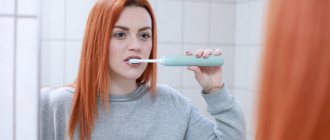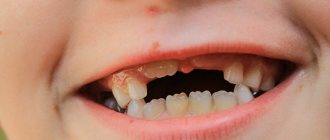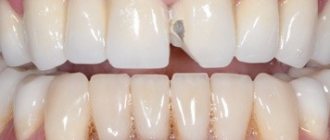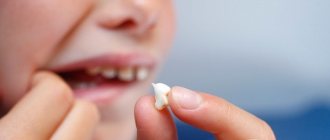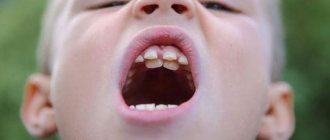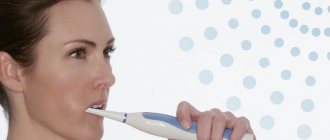Author: Brodsky Sergey Evgenievich Deputy Chief Physician, Candidate of Medical Sciences in the specialties: dentistry and medical microbiology If an adult has a child’s (temporary) tooth, there may be various options for its further existence. What is better, to preserve or remove a baby tooth in an adult patient, can be found in this article.
- Features of children's teeth
- Baby teeth in permanent dentition: reasons
- Removal of baby teeth in adults
- Problems with baby teeth in adults
Echo of childhood
Milk teeth are something from the realm of a carefree and touching childhood, most of us are sure. It is not for nothing that the Scottish writer James Barrie, in the fairy tale about Peter Pan - a boy who did not want to grow up and remained forever young - specifically mentions that “his mouth was full of pearly milk teeth. None have fallen out yet.” Replacing baby teeth with permanent ones is the same step into adulthood as first grade and first grade.
The change of teeth begins at the age of 5–6 and usually ends by the age of 14–16. Moreover, according to the observations of doctors, children are currently replacing their baby teeth with permanent ones at a younger age than several decades ago. But sometimes baby teeth persist into adulthood. People encounter similar cases at 20, 30, and even 50 years old! Why does this happen and what should be done in this case?
Anesthesia for the removal of temporary teeth
The main fear of the child and parents is pain during surgery. But in modern pediatric dentistry there are many effective methods of pain relief, thanks to which the young patient feels comfortable.
Usually, teeth are pulled out for adults under general anesthesia, but weaker infiltration anesthesia works well for children. Children's bones and vessel walls are porous, so the anesthetic quickly penetrates them and “freezes” the desired area for a long time. A guidewire is placed only at the age of 4-7 years during intervention on the lower jaw. This is due to the anatomical structure of molars. Sometimes, along with injections, sedation is used - a special gas that affects the patient’s psycho-emotional state and reduces anxiety.
Children undergo surgery under general anesthesia more often than adults. But parents must understand that general anesthesia means turning off all reflexes, including breathing. Therefore, it is used only when operating on children aged 1 to 4 years, when the child is allergic to drugs, organic lesions of the central nervous system or other methods of pain relief are ineffective.
Despite the fact that the drugs used in pediatric dentistry are safe, the doctor should ask the parents about the child’s chronic diseases and allergic reactions, as well as whether pain relief has been used previously.
Why didn't my baby tooth fall out?
The structure of temporary and permanent teeth has certain differences. Dairy teeth have the same shape as molars, but they are smaller in size, their roots are much shorter, and they grow in the amount of only 20 pieces versus 32 permanent ones, including wisdom teeth. The service life of “children’s” teeth is also short: their roots begin to dissolve (dentists say “resorb”) approximately 2 to 3 years after they are fully formed. The process begins from the area where the crowns of the permanent teeth growing underneath touch them.
However, it happens that the rudiments of molars do not form for some reason. In this case, the roots of the milk teeth most often dissolve under the influence of the rudiments of adjacent permanent teeth. But sometimes this does not happen, and then “children’s” teeth are preserved in adults - doctors call them persistent, from the Latin persistere - to remain, to remain.
The reasons for the absence of permanent tooth buds can be different. Sometimes these are hereditary characteristics, metabolic disorders or disorders of the endocrine glands, trauma and osteomyelitis of the jaws. Chronic and acute inflammatory processes in baby teeth, in particular, periodontitis that is not cured in a timely manner, can also lead to damage and death of the rudiments of permanent teeth.
It also happens that the rudiments of permanent teeth, although they are formed, lie very deep, without touching the roots of milk teeth. This may be caused by insufficient space or misalignment of the permanent tooth. In these cases, milk teeth can remain in an adult.
Delete or leave?
Milk teeth have reduced resistance to the development of caries and other diseases. These teeth are not designed to last. They can interfere with neighboring teeth and visually look different from molars, which disrupts the aesthetics of the smile.
If you find a baby tooth, contact your dentist. The doctor will assess the condition of the tissue and location, degree of destruction and the need for removal. If there are no indications for removal, the dentist will not prescribe this procedure.
Baby teeth are left if:
- the tooth is well preserved and does not interfere with the rest;
- The molar tooth germ is missing, but the roots of the temporary tooth remain intact.
To determine this, the patient needs to undergo an X-ray diagnosis or undergo a 3D tomography. The image will show whether there are prerequisites for the eruption of a permanent tooth, and what is the condition of the milk root.
What to do if an adult’s baby teeth don’t fall out?
Of course, baby teeth often cause problems in adults. Firstly, they are designed to have a short lifespan, and therefore their resistance to caries is much lower than that of permanent teeth. Secondly, baby teeth that do not fall out in time can interfere with the growth of permanent teeth and lead to their incorrect location. However, this does not mean that a baby tooth found in an adult must necessarily be removed. It all depends on each specific case. Most often, doctors recommend keeping well-preserved baby teeth in adults - let them last as long as they can. After all, the permanent ones may never emerge in their place.
In any case, the question of the fate of a baby tooth in an adult is decided only after an x-ray is taken. This will help to find out whether there are rudiments of an unerupted permanent tooth, as well as whether the roots of the baby tooth are being reabsorbed. If there are no rudiments and the roots of the baby tooth have not resolved, while the baby tooth is motionless and looks quite aesthetically pleasing, then it is not worth removing it. The same applies to cases when the permanent tooth, judging by the x-ray, is in such a position that it is impossible for it to erupt even after the removal of the milk tooth.
What to do?
Due to the fact that the lifespan of a baby tooth is much shorter than a molar one, its resistance to caries is much lower, so temporary teeth can cause many problems to their owner. In addition, milk teeth that are not eliminated in time interfere with the development of permanent teeth, stimulating incorrect positioning and the formation of an atypical bite.
However, it is not always necessary to remove a baby tooth when it is discovered. If the germ of a permanent tooth is not observed, that is, a new tooth will not grow, and the milk tooth is in good condition and does not cause discomfort or problems, then dentists recommend preserving it so that the tooth serves its purpose.
The best way to determine the fate of a baby tooth is with an X-ray or CT scan of the jaw. X-ray diagnostics will show whether there are rudiments of a permanent tooth and whether the process of root resorption has begun.
Is it possible to grow a baby tooth on an adult?
If the baby tooth is mobile or does not suit you from an aesthetic point of view, you still need to start with an x-ray examination. If the x-ray reveals that there are no permanent tooth buds, and the roots of the baby tooth have resolved, while the baby tooth has mobility of 3–4 degrees (that is, the tooth is very mobile), then it should be removed and further decide what type Prosthetics are more suitable for you to replace the loss.
If you are not satisfied with the appearance of the tooth, it is necessary, again using an x-ray, to determine the condition of the rudiments of the permanent tooth and the roots of the baby tooth. Further decisions will depend on each specific case, including the age of the patient and the place in the dentition of the baby tooth. If there are no rudiments and the roots of the baby tooth have not resolved, then you can install a veneer on it or carry out a tooth restoration, which will make it invisible in the dentition. And for those who want to completely transform their hair, we can recommend getting lumineers.
If there are rudiments of a permanent tooth, in this case it is worth assessing how much time they need before erupting and making a decision about removing the baby tooth and “pulling out” the permanent one.
Although milk teeth in adults are an anomaly, this is not a reason to necessarily part with them - they can serve you well for many years to come. However, it is possible that this “greetings from childhood” prevents the permanent tooth from growing. So, if you suddenly have a baby tooth, be sure to take an x-ray and consult a specialist.
How to keep your smile?
If there are no molar rudiments in the image and there are indications for removal, the specialists at Family Dentistry will offer to use the prosthetic service.
If the patient is not satisfied with the baby tooth, the doctor can cover it with a veneer or lumineer. It is also possible to perform tooth restoration.
If there are rudiments of a molar tooth, the dentist estimates how long it will take for eruption to occur. For the baby tooth, extraction is prescribed, and the permanent one is helped to erupt faster.
“Baby” teeth in adulthood are not normal. If the tooth is healthy and not causing problems, it can last for many more years. But, natural molars are much better in functionality and aesthetics than baby teeth or dentures restored by a dentist.
Why does a healthy tooth hurt?
Why does a healthy tooth hurt?
Coping with toothache is often very difficult. This is a common problem that can be avoided with proper dental care.
Why does a healthy tooth hurt? The answer to this question can be found by a dentist. Let's consider the main reasons, as well as the algorithm of actions in such situations.
Toothache has a wide range of causes and can be quite difficult to diagnose on your own. The most common causes are damage to the teeth or oral cavity, as well as problems due to poor diet and irregular hygiene procedures.
If the pain is intense, begin to mentally prepare for the fact that you will have dental treatment. If you experience pain in the oral cavity, this may indicate serious problems, including:
- Caries is the most common problem that brings a lot of discomfort. Occurs in most people due to errors in hygiene and the general condition of the whole body
- teeth may be sensitive to different foods, such as ice cream or, on the contrary, hot soup. You can try to help yourself by purchasing toothpaste with desensitizing properties
- if the effects of injury or chewing of hard foods are present, it may result in pain, discomfort or tenderness. It is vital to repair damaged teeth to treat pain and prevent infection or other problems
- When new teeth emerge, they protrude from the gums, causing discomfort and pain. This occurs in baby and adult teeth in children and wisdom teeth in adults.
- Bacteria in the mouth can cause gingivitis, and if left untreated, it can progress to periodontitis. These conditions can cause pain and sensitivity in your teeth and gums.
Other health problems can also be a source of toothache:
- vitamin deficiency
- viral infection, including herpes zoster
- diabetes or diseases affecting the nervous system
- drug or alcohol abuse
We recommend making an appointment with your dentist so they can help diagnose the source of your pain and provide appropriate treatment.
Habits that will help prevent toothache
Depending on the cause of the discomfort, the dentist will prescribe the optimal treatment method. For your part, you can also take care of your health by introducing healthy habits into your life:
- When brushing, you need to achieve perfect cleanliness at least once a day; if necessary, use dental floss
- buy toothpaste that contains fluoride
- eat healthy and regularly
- no smoking
- Go to the dentist regularly for examinations and follow all his recommendations.
What to do if a healthy tooth hurts?
Some effective ways to relieve pain before visiting the dentist:
- take a tablet of Analgin, Ibuprofen or another drug that can relieve pain
- make a cold compress, hold it for a quarter of an hour
- saline rinse (avoid using ice water).
Keep in mind that relieving pain does not treat the underlying cause. Remember that toothache cannot just appear. It is always a warning sign that there is a health problem. Therefore, in such a situation, be sure to make an appointment with the dentist.
Causes of supernumerary teeth.
Until now, scientists have not figured out exactly why supernumerary teeth grow.
But there are several hypotheses according to which polyodontia occurs in humans:
-As a result of splitting of the tooth germ. Polyodontia can appear if the activity of the dental plate is impaired in the fetus during the embryonic period. This can happen due to various viruses, drugs, poor ecology, as well as the mother’s abuse of bad habits and medications during pregnancy.
-Because of atavism. There is a version that polyodontia occurs because the dental system seeks to increase the number of teeth, since nature originally intended 6 incisors on each jaw.
Differences between permanent and temporary units
Temporary and permanent elements of the jaw row are almost identical in shape, but there are some differences:
- dimensions;
- root length;
- chemical composition;
- number in a row;
- life time.
Temporary elements of the jaw rows are designed in size for a growing organism. The jaw of a child or teenager is much smaller than that of an adult.
For a comfortable life, so that the milk units do not put pressure on each other, do not cause pain, inconvenience when chewing food, and do not injure the surrounding tissues, nature prescribes a smaller size.
The shortened length of the root and differences in composition are provided for by the replacement mechanism, for a relatively painless and traumatic passage.
A child grows only 20 milk units, and after the formation of a permanent bite, 32 or 28 elements erupt (not everyone grows four eights or wisdom teeth).
The service life of a temporary unit is reduced due to the difference in composition, their greater susceptibility to various diseases, and lower resistance to caries. That is why it is not recommended to give children a lot of sweets to maintain health.
Stages of formation of permanent dentition and its characteristics.
Read here about possible anomalies that develop with mixed dentition.
At this address https://orto-info.ru/zubocheliustnye-anomalii/okklyuzii/profilaktiki.html we will talk about a kit for the prevention of malocclusions.
